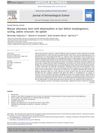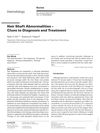Ultrastructural Hair Alterations in Friedreich's Ataxia: A Scanning Electron Microscopic Investigation
July 2015
in “
Microscopy Research and Technique
”
TLDR Friedreich's ataxia causes thin, weak hair with surface damage and cavities.
The study investigated ultra-structural hair alterations in Friedreich's ataxia (FRDA) patients and carriers using scanning electron microscopy. Hair samples from 4 patients at different disease stages and 2 carriers were analyzed. Findings revealed thin and weak hair follicles with cuticular surface irregularities, local damages, and fractures in both groups, with more severe alterations in patients. Unique to patients were cuticle surface erosions and deep cavities beneath the cuticle, along with indistinct cuticular patterns and concavities in advanced disease stages. The study suggested these alterations might result from oxidative stress due to deficient frataxin expression in mitochondria.



